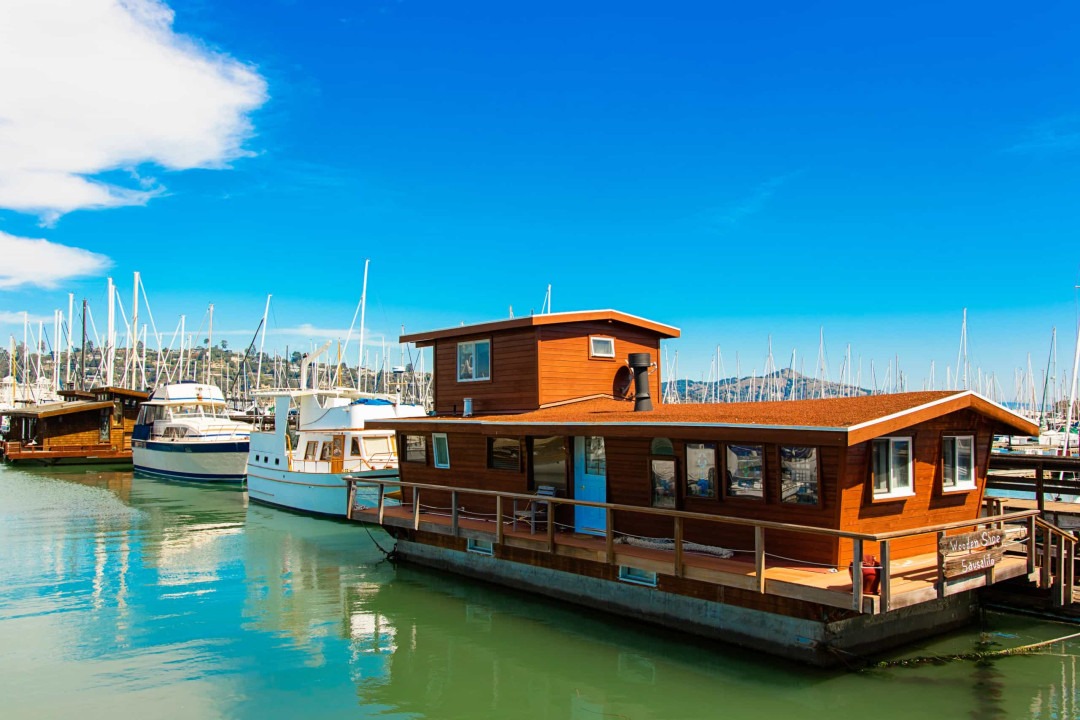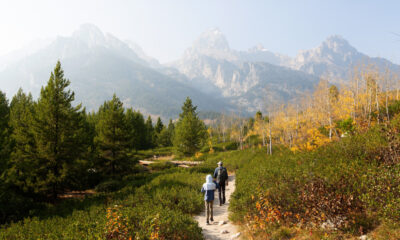Travel
24 Most Dog-Friendly National Parks in the U.S.

If you’ve ever wondered where to take your four-legged best friend on an epic adventure, you’re in luck. Across the United States, many national parks welcome leashed dogs on trails, roads, and in campgrounds—though each park has its own rules and best spots for pups. Below is an overview of 24 standout dog-friendly national parks, organized by state, so you can start planning that next tail‑wagging trip.
Acadia National Park (Maine)
Nestled on Maine’s rugged coast, Acadia is frequently named the most dog‑friendly national park in the country. With over 100 miles of hiking trails and 45 miles of historic carriage roads open to leashed pups, you’ll find plenty of options for seaside strolls and forested paths. Just remember:
-
Where dogs can go: Almost every trail and campground (except Duck Harbor) allows dogs on a leash.
-
Key highlights: Jordan Pond Path, Ocean Path overlooking rocky shores, and Cadillac Mountain’s sunrise (with a sturdy leash and patient pup).
-
Tip: Bar Harbor, the gateway town, is full of dog‑friendly cafés and shops where you can grab a pup‑friendly treat after a long day on the trails.
Cuyahoga Valley National Park (Ohio)
A hidden gem between Cleveland and Akron, Cuyahoga Valley blends Ohio’s industrial history with lush woodlands. Around 110 miles of trails welcome leashed dogs, including 20 miles along the scenic Towpath Trail (part of the Ohio & Erie Canal Towpath). Note that:
-
Restrictions: The East Rim mountain‑bike area and all visitor facilities are off‑limits to dogs.
-
Highlights: Brandywine Falls (view from the boardwalk), the Canal Exploration Center, and frequent wildlife sightings—expect deer, foxes, and plenty of squirrels to chase on scent only.
-
Tip: Look for pet‑friendly rental cabins and B&Bs in nearby Peninsula or Kent to extend your stay.
Shenandoah National Park (Virginia)
Shenandoah is a hiker’s paradise, stretching along 105 winding miles of the Blue Ridge Mountains. Nearly all of Shenandoah’s 500+ miles of footpaths are open to leashed dogs—only about 20 miles are off‑limits (some backcountry trails and a handful of overlooks). You’ll love:
-
Top trails: Stony Man Trail for sweeping valley views, Dark Hollow Falls for a relatively short (but steep) waterfall hike, and parts of the Appalachian Trail (where signed as pet‑friendly).
-
Campgrounds: Big Meadows, Loft Mountain, and Lewis Mountain each welcome pups.
-
Tip: On crisp fall mornings, your dog will revel in the blanket of fiery foliage; bring extra layers for you both as temperatures can drop quickly above 3,000 feet.
Grand Canyon National Park (Arizona)
Few views rival the South Rim of the Grand Canyon. While dogs cannot venture below the rim or ride shuttle buses, they’re welcome on all South Rim trails above the canyon’s edge (including the 13‑mile Rim Trail). Plan around:
-
Rules: Leashed dogs allowed on paved roads, viewpoints, and the Rim Trail. Pets cannot go on inner‑canyon trails (Bright Angel, South Kaibab) or on river‑rafting trips.
-
Dog‑friendly perks: Mather Campground allows leashed pets, and the South Rim’s kennel can board your dog if you want to hike a rim‑below trail without them.
-
Tip: Sunrise and sunset along the Rim Trail are magical (and less crowded than mid‑day). Bring collapsible water bowls, as shade is scarce on canyon overlooks.
Yosemite National Park (California)
Yosemite needs no introduction: towering granite walls, waterfalls, and giant sequoias. Although dogs cannot explore most backcountry or valley trails, they’re allowed in all developed areas, campgrounds, paved roads, sidewalks, and the entire Yosemite Valley Loop Trail (6.5 miles roundtrip). Here’s what to know:
-
Allowed areas: Campgrounds (e.g., Upper Pines, North Pines), paved Valley Loop Trail, sidewalks in Yosemite Village, and parking areas.
-
Off‑limits: Vernal Fall Footbridge, Half Dome cables, and all wilderness paths.
-
Tip: If you’re desperate for a forested hike, head outside park boundaries to Stanislaus or Eldorado National Forests, where off‑leash areas are more common.
Great Sand Dunes National Park (Colorado)
Imagine a sea of shifting dunes at the foot of the Rockies—this is Great Sand Dunes National Park. Leashed dogs can roam the dune field, wade in Medano Creek (seasonally), and hike nine miles of official trails. Keep in mind:
-
Where dogs can go: Dunes, Medano Creek (when flowing), and most interpretive trails. Leashes are always required.
-
Best experiences: Watch your pup attempt (and likely fail) to sprint up a steep sand slope—hilarious and guaranteed to tire them out.
-
Tip: Midday sand can scorch paws in summer; aim for dawn or dusk, and bring booties if your pup is sensitive to heat.

New River Gorge National Park and Preserve (West Virginia)
As one of America’s newest national parks, New River Gorge blends cliffside views, whitewater rapids, and dense hardwood forests. Fortunately, all in‑park trails allow leashed dogs, including the well‑known Endless Wall Trail (6.3 miles roundtrip) and the Grandview Rim Trail (3 miles).
-
What to expect: Spectacular rim‑high vistas, rock‑climbing routes along the gorge walls, and the historic Nuttall sandstone features.
-
Camping: Fayetteville and Summers County have several dog‑friendly campgrounds; within the park, Ames and Canyon Rim campgrounds allow pups.
-
Tip: If you want sunrise or sunset photos, Grandview Point is a short walk from the parking area—perfect when you’d rather not tackle miles of trail before sunrise.
Congaree National Park (South Carolina)
Home to the tallest deciduous forest canopy in North America, Congaree’s boardwalks and footbridges wind through a swampy wonderland of cypress and tupelo trees. Leashed dogs are welcome on all trails and boardwalks, as well as in campgrounds. Key highlights:
-
Boardwalk Loop Trail (2.4 miles): Flat, shaded, and studded with interpretive signs—ideal for all skill levels.
-
Dog-friendly paddle: Rent a canoe at Cedar Creek Landing (outside the park) and float the mountain‑clear water beneath a cathedral of old‑growth trees (dogs can ride along if properly secured).
-
Tip: Bugs can be fierce in warmer months—bring a pet‑safe insect repellent or opt for shoulder‑season visits (autumn for colorful leaves, spring for wildflowers).
North Cascades National Park (Washington)
“American Alps” is not an overstatement here—North Cascades is rugged, remote, and jaw‑droppingly beautiful. Though most wilderness trails restrict dogs, there are pockets where leashed pups can explore:
-
Allowed zones: Ross Lake National Recreation Area and Lake Chelan National Recreation Area—both units adjacent to the park that allow dogs on certain trails.
-
On‑park roads: The North Cascades Highway (State Route 20) provides several pullouts and short spur trails where pups on leash can stretch their legs.
-
Tip: Check with Ross Lake visitor centers for up‑to-date dog‑friendly trail maps—conditions can change rapidly due to weather or wildfire risk.
White Sands National Park (New Mexico)
South of Alamogordo, endless waves of white gypsum create a surreal, desert‑like landscape. Leashed dogs can roam the dunes, hike all nine miles of marked trails, and even picnic in designated areas.
-
Why pups love it: The gypsum sand stays cool to the touch even in summer—your dog can chase sand plumes without burning paws.
-
Best trails: Dune Life Nature Trail (1 mile, interpretive signs) and Playa Trail (3.6 miles roundtrip to the old ranch site).
-
Tip: Bring plenty of water and a collapsible bowl—shade is virtually non‑existent once you slip beyond the edge of the sand field.

©Getty Images
Hot Springs National Park (Arkansas)
Hot Springs isn’t just about thermal springs—its 26 miles of hiking trails weave through the Ouachita Mountains, and nearly all are open to leashed dogs. You’ll find:
-
Dog-friendly trails: West Mountain Trail (2.3 miles), Gulpha Gorge Trail (6 miles roundtrip with waterfall views), and Hot Springs Mountain Tower access road (paved, up to the tower, with leash).
-
Relaxation: After hiking, cool off at the local dog‑friendly breweries and cafés in downtown Hot Springs.
-
Tip: Squeeze in a soak at Bathhouse Row while staying in a kennel or pet‑friendly lodging—just outside park boundaries you’ll find several options to board your pup.
Indiana Dunes National Park (Indiana)
On the southern tip of Lake Michigan, this park is a striking mix of dunes, wetlands, prairies, and forest and has been America’s newest national park since 2019. Leashed dogs can join you on most trails and beaches, including:
-
Key beaches: West Beach and National Lakeshore Beach allow pups (check seasonal restrictions if swimming is planned).
-
Popular trails: Dune Succession Trail (1.5 miles), Cowles Bog Trail (3.5 miles), and River Trail (8.8 miles roundtrip).
-
Tip: Parking fills quickly on summer weekends—arrive early if you plan a sunrise or sunset stroll with your dog along the shoreline.
Mammoth Cave National Park (Kentucky)
World’s longest known cave system (over 400 miles explored), Mammoth Cave also hinges above‑ground adventures in dense hardwood hills. Leashed dogs are allowed on surface trails and in designated campground areas (no dogs down below).
-
Dog-friendly recommendations: Green River Bluffs Trail (4.2 miles), Cedar Sink Trail (0.75 miles, sinkhole views), and the River Styx Access Road (biking/pedestrian path).
-
Overnight stay: Mammoth Cave Campground welcomes pups; you can even rent a yurt if you want to try “glamping” aboveground.
-
Tip: Temperatures in cave entrances can be cool year‑round—bring a jacket for both you and a dog coat for short T‑haired breeds, in case you decide to peek inside park buildings (though not into the cave itself).
Petrified Forest National Park (Arizona)
Step back in time (and walk across millions of years) at Petrified Forest, where ancient logs have fossilized into colorful quartz and agate. The good news for dogs: they’re allowed anywhere outside park buildings on a leash, including:
-
Allowed paths: Blue Mesa Trail (1‑mile loop through badlands), Crystal Forest Trail (0.75 miles through brilliant petrified wood), and Chinde Point Trail (1‑mile roundtrip wilderness route).
-
Tip: The Painted Desert Rim Trail (1/3 mile) provides stunning overlook photo ops—arrive early to beat both crowds and midday heat.
Zion National Park (Utah)
Iconic Zion Canyon’s soaring cliffs and narrow slot canyons draw hikers from everywhere, but pet restrictions are tighter here. Still, dogs are welcome on the utterly scenic Paʹrus Trail (3.5 miles roundtrip) that runs from the South Rim Visitor Center west to Canyon Junction. In addition:
-
Allowed areas: Village green spaces (Zion Lodge grounds), campgrounds, and paved roads.
-
Tip: If you renovate your plans around dog restrictions, consider hiking nearby BLM land or the Kolob Terrace Road corridor (outside the main canyon), where fewer crowds and some pet‑friendly paths exist.
Rocky Mountain National Park (Colorado)
While most high‑elevation trails are closed to pets, the park still provides gorgeous views and easy strolls in developed areas:
-
Leashed options: Lakeside trails around Bear Lake (fish can’t be chased beyond shore), paved roads (e.g., Old Fall River Road when open), and campgrounds (Upper, Glacier Basin, Aspenglen).
-
Nearby bonus: Roosevelt National Forest and Arapaho National Forest border the park—if you want a full day of canine‑friendly hiking at altitude, look into trails there (e.g., Brainard Lake Recreation Area).
-
Tip: Bear Lake Road can be very windy and slow; secure your pup properly in your vehicle before venturing above 8,000 feet.
Bryce Canyon National Park (Utah)
The otherworldly hoodoos of Bryce Canyon are best appreciated from a series of overlooks, and pups can join you almost everywhere aboveground:
-
Allowed areas: Paved roads, pullouts, campgrounds (North Campground), and the shared‑use path between the Visitor Center and Inspiration Point (1 mile, paved).
-
Restricted trails: Navajo Loop, Queen’s Garden, and Peek‑a‑Boo trails are off‑limits (steep and unpaved).
-
Tip: Attend a stargazing program with your dog at your side—Bryce is an International Dark Sky Park, so after sundown the Milky Way practically leaps out.
Joshua Tree National Park (California)
Joshua Tree’s surreal desert landscape has become a mecca for climbers, photographers, and stargazers. Dogs are allowed on paved roads (e.g., Park Boulevard, Pinto Basin Road), campgrounds, and at the Jumbo Rocks and Black Rock campgrounds. However:
-
Trail rules: Most trails are closed to dogs, including Hidden Valley, Barker Dam, and Ryan Mountain.
-
Tip: Early‑morning desert walks in campgrounds reveal creatures of the night—rodents, rabbits, and the occasional roadrunner—as your pup explores cooler temperatures.
Arches National Park (Utah)
Famous for its more than 2,000 natural sandstone arches, this park’s red‑rock scenery is mesmerizing. Unfortunately, pups are quite restricted here:
-
Allowed: Paved roads, parking areas, and the entire campground at Devils Garden Campground.
-
Prohibited: Any audible trail (e.g., Delicate Arch Viewpoint Trail, Landscape Arch Trail).
-
Tip: If you want to keep exploring beyond the campground loop, head a few miles east to the Sand Flats Recreation Area near Moab—several pet‑friendly trails (like the Slickrock Bike Trail) welcome leashed dogs.
Canyonlands National Park (Utah)
Canyonlands has three main districts—Island in the Sky, The Needles, and The Maze—but pet access is limited to paved overlooks and access roads. Dogs can roam lightly:
-
Where dogs can go: Two Roads Road (toward White Rim Overlook) and the entire camping area at Island in the Sky (some backcountry campgrounds allow pups with appropriate permits).
-
Tip: For true dog‑friendly Mesa‑country hiking, explore the adjacent BLM land (e.g., White Rim Road 4×4 route) where dogs on leash are allowed on many dirt roads and social trails.
Capitol Reef National Park (Utah)
Remote and lesser‑visited, Capitol Reef’s sculpted sandstone domes are enchanting, but like most Utah red‑rock parks, dog access is restricted:
-
Allowed areas: Campgrounds (Fruita Campground), paved picnic areas, and roads through the Fruita Historic District.
-
Prohibited: Most trails (e.g., Cassidy Arch, Hickman Bridge).
-
Tip: For a family stroll with your pup, take the short paved path to the Gifford House (pet‑friendly orchard tours in spring if you time it right).
Crater Lake National Park (Oregon)
Famous for its deep-blue, glacier‑carved lake, Crater Lake allows leashed pups on certain scenic paths and campgrounds:
-
Dog‑friendly trails: Sun Notch Trail (1 mile roundtrip with a view of Phantom Ship), offshoots of Rim Drive (where pullouts allow short hikes), and portions of the Pacific Crest Trail (north of park boundaries).
-
Camping: Mazama Campground (open late June through late September) welcomes leashed dogs.
-
Tip: Weather can shift from sun to snow unexpectedly—even in summer—so bring a doggie jacket if you plan a lakeside cliff walk.
Glacier National Park (Montana)
Glacier’s jagged peaks and turquoise lakes are legendary. Dogs are allowed on about 70 miles of park roads and three designated trails: McDonald Creek Trail (3 miles roundtrip), Apgar Lookout Trail (3.6 miles roundtrip), and the paved Path to the Village at Apgar (perfect for a flat, lakeside stroll). In addition:
-
Allowed areas: Parking areas, campgrounds (Fish Creek, Apgar, and St. Mary), and most shoreline areas (leave driftwood alone!).
-
Tip: Mornings in late spring bring lower crowds—Apgar Village is often quiet enough to enjoy breakfast with your pup at the Lake McDonald Lodge patio before heading out on the McDonald Creek Trail.
Hot Springs National Park (Arkansas)
Yes, we return to Hot Springs one more time—because it truly is one of the most overlooked dog‑friendly destinations in the National Park System. Leashed dogs can roam:
-
Dog‑approved trails: West Mountain Trail, Hot Springs Mountain Tower paved road, and all Seven Lakes Loop trails.
-
Campgrounds: Gulpha Gorge Campground is small but peaceful, with creekside sites perfect for cooling your dog off after a hot day.
-
Tip: Since the springs themselves (historic bathhouses) don’t allow dogs, consider a nearby pet‑friendly Airbnb or cabin if you want to sample Bathhouse Row.
Planning a Perfect Pup-Friendly National Park Adventure
When preparing for any national park trip with your dog, keep these general guidelines in mind:
-
Leash Up Everywhere: Even if a park has off‑leash areas, most trails and campgrounds require dogs to be on a maximum six-foot leash.
-
Pack for Pups: Bring collapsible bowls, plenty of water, dog‑safe sunscreen, a brush (for windy or snowy parks), and booties for hot sand or salt.
-
Scout the Weather: Alpine and desert parks can have extreme temperatures. Early morning and late afternoon hikes often offer the safest conditions for paws.
-
Clean Up: Carry enough waste bags, and always leave no trace—many parks have zero‑tolerance policies for dog waste left on trails.
-
Check Updates: Park policies change seasonally (e.g., wildfire closures, flooding). Review the official National Park Service pet policy page for each park right before you go.
Whether your pup thrives in a seaside Maine breeze or jumps for joy amid Colorado’s shifting dunes, these 24 dog-friendly national parks are some of the best places to create lifelong memories together. From short boardwalk strolls to scenic rim drives, there’s a park (and path) to match every dog’s energy level and curiosity.
Adventure—and wagging tails—await!
Sources: (Outside) (Travel + Leisure)
Travel
The Pros and Cons of Living on a Houseboat

Introduction
Is the idea of living on a houseboat calling your name? Picture waking up to gentle waves lapping at your hull, the sunrise painting the water in gold, and a community of fellow boaters waving from their decks. This romantic vision is precisely why more people are swapping traditional homes for life afloat. But is it all smooth sailing? In this guide, we’ll explore the real-world benefits and challenges of floating home life, drawing on data and firsthand experiences to help you decide if this unconventional lifestyle is right for you.
Video Credit: https://www.youtube.com/@livingbig
Is it the lifestyle for you?
Living on a houseboat isn’t just a change of address—it’s a complete shift in mindset. You’ll trade sprawling rooms for cozy cabins and manicured lawns for ever-changing waterfront views. Ideal candidates tend to be:
- Adventure-seekers who crave daily variety.
- Minimalists happy to live with fewer possessions.
- Nature-lovers excited by wildlife and ever-changing weather.
Before taking the plunge, rent a houseboat for a short getaway. That weekend test run will reveal whether you relish the dockside camaraderie or yearn for dry land comforts.

© Shutterstock
What are the costs involved?
Budgeting accurately is critical. Here’s a breakdown of typical expenses in the United States:
| Expense Category | Typical Range (US) |
|---|---|
| Purchase Price | $6,000–$300,000+ (used vs. brand-new custom builds) (Houseboats for sale – Boat Trader, 15 Questions You Should Ask Before Buying a Houseboat – Neighbor) |
| Mooring Fees | $2,000–$4,000 per year (location dependent) (Houseboat Dock Slip Fees – What Prices or Rates, do Marinas Cost …) |
| Maintenance & Repairs | $1,200–$3,500 per year (annual haul-outs, tune-ups) (the costs to run, own, or operate house boats? – All About Houseboats) |
| Utilities & Pump-Out | $1,200–$2,400 per year (electricity, water, sewage) (Cost of Living On A Houseboat Year Round) |
| Insurance | $500–$2,000 per year (comprehensive coverage) (the costs to run, own, or operate house boats? – All About Houseboats) |
Factor in the fees
Beyond mooring, marinas often charge extra for amenities:
- Liveaboard fees: Many charge $5–$8 per foot of boat length each month.
- Utilities surcharges: High-demand seasons can spike electricity costs.
- Internet & laundry: Some marinas bundle services; others bill them separately.
In high-demand urban areas like London, annual mooring fees have soared to over £15,000—more than 50% above 2015 levels—pushing some residents out of the market (London houseboat residents fear rise in mooring fees will price them out).
New or used?
Used houseboats often come “as-is” at a fraction of the cost, but may need immediate repairs. New builds let you customize layout, insulation, and engine specs, yet can top $300,000 (15 Questions You Should Ask Before Buying a Houseboat – Neighbor, How Much Does It Cost to Build a Houseboat? – SoFi). Consider your comfort with DIY maintenance versus ready-to-move-in convenience.
What will you use it for?
- Full-time living: Requires reliable utilities, storage solutions, and often a residential mooring permit.
- Weekend or vacation retreat: Allows looser mooring rules and lighter maintenance.
- Cruising: Opt for an engine-equipped vessel with fuel capacity and navigation gear.
Your intended use directly shapes boat size, engine requirements, and onboard amenities.
Houseboat or floating home?
Although often used interchangeably, there’s a key difference:
- Houseboat: Self-propelled, built for movement.
- Floating home: Stationary, like a barge tethered to land.
This distinction affects insurance, financing, and regulatory compliance—so clarify before you buy.
Financial advantages
While maintenance and mooring fees add up, many liveaboards enjoy:
- Lower property taxes (varies by state and marina).
- Reduced heating/cooling costs thanks to thermal mass of water.
- Potential vessel-specific tax breaks in certain jurisdictions.
The downsides
Despite the romance, life on the water comes with trade-offs:
- Space constraints: Storage is at a premium.
- Maintenance demands: Annual haul-outs and constant checks become routine.
- Weather dependency: Storms and cold snaps can disrupt daily life.
Below is a quick at-a-glance comparison:
| Pros | Cons |
|---|---|
| Lower overall housing costs | Limited living space |
| Mobility and adventure | Time-intensive maintenance |
| Close-knit water communities | Mooring logistics and fees |
| Eco-friendly minimalism | Vulnerable to weather and flooding |
Asset or hindrance?
Unlike traditional homes, many houseboats depreciate over time—especially basic pontoon models. If you view your boat as an investment, discuss resale values with a broker and look for well-built brands known to hold worth.
Flood risks
Living on inland waterways or rivers carries inherent flood dangers. Research historical water levels, install proper fendering and bilge systems, and invest in weather alerts to safeguard your floating home.
Potential transport costs
Relocating by water can be straightforward, but:
- Interstate moves often require overland trucking—easily $1,000+ per trip.
- Fuel costs surge if you plan frequent cruising.
Budget relocation into your long-term plan.

© Shutterstock
The need for speed?
Most houseboats cruise at a leisurely 6–10 knots. While custom models can hit 34 knots (about 40 mph), speed is rarely the priority. Comfort, efficiency, and fuel economy usually win out.
Interior motives
Onboard design leans compact:
- Open-plan layouts maximize perceived space.
- Multi-use furniture (e.g., convertible benches) is a must.
If you crave sprawling rooms, life afloat might feel too cramped.
Fit for the family?
Families must plan for privacy and storage. A 30 ft boat suits solo or couple living, but a four-member family will need 50 ft+ vessels to accommodate two cabins and living areas.
Size matters
Narrow boats around 50 ft long are popular with first-timers for maneuverability. A 65 ft model often includes a guest cabin and dedicated workspace—ideal for remote workers.
Pet concerns
Dogs adapt well to life on the water, enjoying deck walks and fetch games by the shore. Cats may struggle unless in a static floating home with secure railings and safety netting.
Residential moorings
Securing a permanent berth can be challenging. Spaces fill quickly in desirable areas, and waiting lists are common. Factor in school runs, grocery trips, and commuting when choosing a marina.
Weather warning
Winters on the water can be damp and chilly. Ensure your boat has:
- Efficient heating (webasto or diesel heaters).
- Proper insulation in hull and windows.
- Weatherproof seals to keep leaks at bay.
Living on a houseboat offers unparalleled freedom, closeness to nature, and a tight-knit community—but it also demands adaptability, ongoing upkeep, and thoughtful budgeting. If you’re drawn to a minimalist, adventurous lifestyle and ready to trade square feet for waterfront vistas, it could be your dream home afloat.
Sources: (Deep Sailing) (Book2Sail)
Travel
Delicious and Easy Boating Recipes for Your Next Family Adventure

But let’s be honest—cooking on a boat isn’t always easy. Limited space, unpredictable weather, and the need for quick, hassle-free meals can make meal planning a challenge. That’s why having a collection of simple, delicious, and boat-friendly recipes is essential.

In this guide, we’ll explore some of the best boating recipes that are easy to prepare, packed with flavor, and perfect for family adventures. From hearty breakfasts to light lunches and satisfying dinners, these dishes will keep everyone happy and energized throughout your trip.
Quick & Easy Breakfast Burritos
Why They’re Perfect for Boating:
- Portable and mess-free
- Customizable with favorite fillings
- Packed with protein to fuel a day of activities
Ingredients:
- 4 large flour tortillas
- 6 eggs, scrambled
- 1 bell pepper, diced
- 1 small onion, chopped
- ½ cup cooked breakfast sausage or bacon
- ½ cup shredded cheese
- Salsa (optional)
Instructions:
- In a skillet, sauté the bell pepper and onion until tender.
- Add the scrambled eggs and cooked meat, stirring until fully combined.
- Warm the tortillas, then spoon the egg mixture onto each one.
- Top with cheese and salsa, then roll into burritos.
- Wrap in foil for easy handling and enjoy!
Pro Tip: Prep the filling ahead of time and store it in a cooler for a quick morning assembly.
Grilled Chicken & Veggie Skewers
Why They’re Perfect for Boating:
- Minimal cleanup (only one skewer per person!)
- Nutritious and filling
- Great for grilling on a boat BBQ
Ingredients:
- 2 boneless chicken breasts, cut into strips
- 1 bell pepper, chopped
- 1 zucchini, sliced
- 1 cup cherry tomatoes
- 2 tbsp olive oil
- 1 tsp garlic powder
- 1 tsp Italian seasoning
- Salt & pepper to taste
Instructions:
- Marinate chicken in olive oil, garlic powder, Italian seasoning, salt, and pepper.
- Thread chicken and veggies onto skewers.
- Grill over medium heat for 10-12 minutes, turning occasionally.
- Serve with rice or couscous for a complete meal.
Fresh & Flavorful Caprese Salad
Why It’s Perfect for Boating:
- No cooking required
- Light and refreshing on hot days
- Simple yet elegant
Ingredients:
- 2 large tomatoes, sliced
- 8 oz fresh mozzarella, sliced
- ½ cup fresh basil leaves
- 2 tbsp balsamic glaze
- 2 tbsp extra virgin olive oil
- Salt & pepper to taste
Instructions:
- Alternate tomato, mozzarella, and basil on a plate.
- Drizzle with balsamic glaze and olive oil.
- Season with salt and pepper.
Easy Pasta Salad with Pesto Dressing
Why It’s Perfect for Boating:
- Can be made ahead of time
- Versatile—add any protein or veggies
- Serves a crowd
Ingredients:
- 8 oz rotini or penne pasta
- ½ cup pesto sauce
- 1 cup cherry tomatoes, halved
- ½ cucumber, diced
- ¼ cup olives
- 1 cup grilled chicken or shrimp (optional)
Instructions:
- Cook pasta according to package instructions, then rinse with cold water.
- Toss with pesto, veggies, and protein.
- Chill before serving.
Flavorful Fish Tacos with Mango Salsa
Why They’re Perfect for Boating:
- Fresh and light
- Tropical flavors enhance the boating vibe
- Quick to assemble
Ingredients:
- 1 lb white fish (mahi-mahi, tilapia, or cod)
- 1 tbsp chili powder
- 1 tsp cumin
- 1 tsp garlic powder
- 8 small tortillas
- 1 mango, diced
- ¼ cup red onion, chopped
- ¼ cup cilantro, chopped
- 1 lime, juiced
Instructions:
- Season fish with spices, then grill until flaky.
- Mix mango, red onion, cilantro, and lime juice for salsa.
- Serve fish in tortillas topped with salsa.
Classic Cheeseburger Sliders with Potato Chips
Why They’re Perfect for Boating:
- Kid-friendly
- Easy to eat while lounging on deck
- Satisfies burger cravings without a full grill setup
Ingredients:
- 1 lb ground beef
- 8 slider buns
- 4 slices cheddar cheese
- Lettuce, tomato, pickles (optional)
- Ketchup & mustard
Instructions:
- Form small beef patties and grill until done.
- Add cheese, then assemble on buns with toppings.
- Serve with chips for a classic combo.
Final Thoughts: Making Mealtime Memorable on the Water
Food is more than just fuel—it’s part of the adventure. With these easy, delicious recipes, you can spend less time stressing over meals and more time enjoying the water with your family. Whether you’re grilling skewers at sunset or assembling quick breakfast burritos before a day of fishing, these dishes will keep everyone happy.
Travel
The Secret to Exploring Europe Without Breaking the Bank in 2025

I’ll never forget my first night in Kraków—sitting in a cozy underground jazz bar, sipping a €3 craft beer, and marveling at how far my money stretched. Nearby, a group of students debated philosophy over pierogi plates that cost less than a metro ticket in Paris. That’s when it hit me: Europe doesn’t have to be expensive.
While cities like London and Zurich drain wallets faster than you can say “souvenir,” a parallel Europe exists—one where medieval streets, sun-drenched plazas, and buzzing food markets come with shockingly small price tags. Thanks to research from Time Out, The Times, and backpacker surveys, we’ve uncovered the continent’s best-kept secrets for 2025: places where €50 a day buys you hearty meals, comfy hostels, and unforgettable adventures.
Picture this: in Romania’s Cluj-Napoca, you can feast on chimney cake and local wine for under €10. In Portugal’s Porto, a tram ride to the Atlantic cliffs costs less than a coffee in Oslo. And in Serbia’s Belgrade, all-night riverside parties won’t cost you a single cover charge. These aren’t compromises—they’re steals.
But affordability isn’t just about cheap beer (though that helps). It’s about cities where free walking tours reveal hidden histories, where public parks double as picnic paradises, and where trains to nearby villages cost pocket change. Even better? Many are trending among savvy travelers before the crowds (and prices) catch on.
So skip the overpriced capitals. Ahead, discover 21 destinations where your euro stretches furthest—plus a few shockingly expensive spots to avoid. Your dream European adventure might cost less than you think…
Tirana, Albania
Tirana, Albania, might just be Europe’s best-kept budget secret—a city where your money stretches further than you ever imagined. Picture this: sipping a rich, velvety espresso for just €1 at a sidewalk café while watching the world go by. Or feasting on flaky, savory byrek fresh from the oven for less than you’d pay for a sandwich back home. This is a place where history, culture, and adventure come without the hefty price tag of more tourist-heavy European capitals.
Stroll through the city center, and you’ll find a fascinating blend of Ottoman-era architecture, Communist-era relics, and vibrant street art that gives Tirana its unique character. The Pyramid of Tirana, a surreal concrete structure left over from the Communist regime, stands as a testament to the city’s layered past—and climbing it costs nothing but a bit of effort. Nearby, the Bunk’Art museums (entry fee: just €3) transform Cold War bunkers into immersive historical exhibits, offering a glimpse into Albania’s complex history.
When hunger strikes, you won’t have to dig deep into your pockets. A hearty meal of tavë kosi (tender baked lamb in yogurt) or a plate of grilled meats with fresh bread rarely tops €5 at local eateries. For something quick, grab a crispy petulla (Albanian fried dough) drizzled with honey from a street vendor—it’s the perfect sweet pick-me-up for under €1.
As the sun sets, Tirana’s energy shifts. The Blloku district, once reserved for Communist elites, is now the city’s nightlife hub, where cocktails cost less than €5 and live music spills onto the streets. Prefer something more low-key? Take the Dajti Express cable car (€5 round-trip) up the mountain for breathtaking views over the city, or hop on a €1 furgon (shared minibus) to explore nearby villages and hiking trails.
Tirana isn’t just affordable—it’s alive with character, warmth, and surprises around every corner. It’s the kind of place where you can live richly on a shoestring budget, discovering hidden gems without the crowds or the markup. For travelers looking to experience Europe’s soul without draining their wallets, Tirana is waiting with open arms—and unbeatable prices.
Kaunas, Lithuania
Kaunas, Lithuania, quietly steals the hearts of budget travelers with its perfect mix of culture, history, and affordability. Imagine sipping a craft beer for €2.50 in a funky bar housed in a former Soviet factory, or wandering through avant-garde art galleries where admission costs less than a cup of coffee. This former European Capital of Culture (2022) delivers big experiences on small budgets, making it one of Eastern Europe’s smartest getaway choices.
The city’s creative energy pulses through its streets – from the haunting beauty of the Ninth Fort (entry just €4) to the free walking tours that reveal Kaunas’ interwar architecture and quirky stories. Foodies rejoice at Laisvės Alėja, the main pedestrian street, where a three-course Lithuanian meal at a traditional tavern costs about €10. Don’t miss cepelinai, the iconic potato dumplings that fill stomachs without emptying wallets.
Accommodation surprises too – stylish hostels with designer interiors offer beds from €12, while boutique hotels stay under €50. The best part? Kaunas’ compact size means you’ll spend nothing on transport, with all major sights within walking distance. As night falls, join locals in the buzzing Vilniaus Street bars where cocktails cost half what you’d pay in Vilnius.
Porto, Portugal
There’s something magical about sitting by the Douro River at golden hour, a glass of rich port wine in hand, knowing this sublime moment cost you less than €3. Porto is that rare Western European gem where medieval alleys, world-class wines, and postcard-perfect views come without the premium price tag of other coastal cities.
While Lisbon’s popularity sends prices climbing, Porto retains its authentic soul – and shockingly reasonable costs. A typical day here might begin with a €1.50 bica (espresso) and flaky pastel de nata at a historic café, followed by free entry to São Bento Station to marvel at its 20,000 azulejo tiles. Lunch means feasting on a francesinha – Porto’s legendary meat-and-cheese sandwich smothered in beer sauce – for about €8 at a local tasca.
The city’s greatest luxuries are surprisingly accessible:
- Wine tasting at centuries-old port cellars in Vila Nova de Gaia (€10-15 with samples)
- River cruises under Dom Luís I Bridge (from €12)
- Tram 1 rides to the Atlantic coast (€3.50)
Evenings unfold in Ribeira’s lantern-lit alleys, where €3 glasses of vinho verde flow freely. Stay in a charming guesthouse for €40/night or a stylish hostel dorm for €15. And unlike other European hotspots, Porto’s attractions never feel overcrowded – you’ll have those breathtaking Miradouro views practically to yourself.
From the €2.30 bolinhos de bacalhau (cod fritters) at Mercado do Bolhão to free Fado performances in backstreet bars, Porto proves you can experience Portugal’s soul without sacrificing your budget. It’s not just affordable – it’s unforgettable.
Pro tip: Buy a €7 Andante Tour 24h card for unlimited public transport, including trains to the stunning Douro Valley wine regio
Zagreb, Croatia
While everyone flocks to Croatia’s sun-drenched coast, savvy travelers quietly discover Zagreb – a capital where Austro-Hungarian grandeur meets quirky creativity, all at prices that’ll make you do a double-take. Here, your euro stretches like warm burek dough, covering everything from tram rides to truffle pasta without the coastal markups.
Start your day with a €1 kava at one of the historic kavanas around Ban Jelačić Square, then hop on the world’s shortest funicular (€0.50) to Upper Town. You’ll find:
- Free museums like the haunting Museum of Broken Relationships (leave a donation)
- €5 lunch specials of štrukli (cheese-filled pastry) at local bistros
- €2.50 craft beers in Tkalčićeva’s vibrant bars
The city rewards those who look beyond the obvious. Hunt for street art in the industrial-style District of Culture, picnic in lush Maksimir Park (Croatia’s oldest public garden), or browse Dolac Market’s flower stalls and fresh produce – where a kilo of cherries costs less than a Dubrovnik gelato.
As night falls, join locals at hidden wine bars pouring Istrian malvazija for €3/glass, or catch underground DJ sets in former factories. Accommodation? Think €15 hostel beds in art-nouveau buildings or €50 boutique hotels that’d cost triple on the coast.
With its tram network (€1 tickets), walkable center, and lack of tourist crowds, Zagreb offers authentic Croatia without the premium. It’s not just a budget alternative – it’s a revelation waiting to be explored.
Bucharest, Romania
Beneath the grand Belle Époque boulevards and communist-era blocks, Bucharest thrums with an energy that won’t quit – and won’t drain your wallet. This is where €5 buys you a feast, €2 gets you a craft beer, and nightclubs in former factories keep the music pumping until sunrise… all without a cover charge.
Start your Bucharest adventure in the Old Town’s maze of cobbled streets, where:
- Traditional carafes of house wine flow for €3 at basement taverns
- Mici (grilled minced meat rolls) with mustard cost less than €1 from sidewalk grills
- 19th-century pastry shops serve cream-filled papanasi desserts for €2.50
The city reveals its magic in contrasts:
- Free communist walking tours past Ceaușescu’s megalomaniacal Palace of Parliament
- Hidden jazz bars in pre-war villas where cocktails cost €4
- Underground clubs in abandoned industrial spaces with €3 beers
By day, explore Village Museum’s pastoral cottages (€3 entry) or Herăstrău Park’s lakeside paths. By night, join locals bouncing between hipster cocktail dens and thumping electronic temples where the party stretches past dawn.
Sleep in a chic hostel for €10/night or a boutique hotel for €40. Ride the efficient metro for €0.50 a trip. Bucharest doesn’t just give you value – it gives you vibrant, unfiltered Eastern European soul at prices that feel stolen.
Sofia, Bulgaria
Under the watchful gaze of snow-capped Vitosha Mountain, Sofia works its magic quietly – a city where golden-domed churches stand shoulder-to-shoulder with socialist-era monuments, where mineral springs bubble up in ancient Roman ruins, and where your money seems to multiply mysteriously. This is Europe’s most affordable capital, a place where €20 buys a full day of feasting, culture, and unexpected delights.
Start your morning like locals do – with a €0.80 espresso and flaky banitsa pastry at a Soviet-style kafené, then follow the “yellow brick road” (actually yellow cobblestones) to:
- The Alexander Nevsky Cathedral’s golden domes (free to enter)
- Ancient Serdica ruins beneath metro stations (free viewing platforms)
- The mineral water fountains near the mosque (fill your bottle for free)
At lunch, dive into €3-5 menu deals – maybe shopska salad with rakia liquor, or a steaming clay pot of kavarma stew. Then spend your afternoon:
- Soaking in thermal baths at Central Mineral Baths (€10 for 2 hours)
- Hiking Vitosha Mountain’s trails (free, just take bus 66 from the city)
- Browsing the Ladies’ Market for €1 jars of rose products
As evening falls, join students in the hidden “Bar-Art” scene:
- Craft beers for €1.50 in graffiti-covered courtyards
- Live jazz in former antique shops (cover charge rarely over €3)
- Secret communist-era bars serving €2 cocktails
Sleep in a boutique hostel for €8/night or a 4-star hotel for €40. Ride the metro anywhere for €0.80. With its small-town vibe, mountain backdrop, and absurd affordability, Sofia isn’t just cheap – it’s an open secret among travelers who prefer substance over hype.
Argos, Greece
Step off the tourist trail and into a living museum – Argos, one of Europe’s oldest continuously inhabited cities, where 3,000 years of history unfold between quiet cobblestone streets and sun-baked ruins. While crowds overpay in Santorini, you’ll be sipping €1.50 freddo cappuccinos in shadowy plateias, having archaeological sites practically to yourself, and sleeping in family-run guesthouses for €30 a night.
Time Travel on a Budget:
- The Ancient Theatre of Argos (€2 entry) still hosts performances where Sophocles’ plays once debuted
- Climb the Larissa Castle (free) for panoramic views over the Argolic Gulf
- Wander the Roman Baths and Agora ruins with no entrance fees or queues
Local Life Unfiltered:
- Meze-style dining at kafeneios where €10 buys grilled octopus, stuffed tomatoes, and house wine
- The weekly laiki market with €1 baskets of olives and just-picked oranges
- Hidden Byzantine chapels tucked between orange groves, free to explore
Strategic Base:
Argos’ central Peloponnese location makes it ideal for day trips by bus (€2-5 fares):
- Nafplio’s Venetian charm (30 mins)
- Mycenae’s Lion Gate (20 mins)
- Epidaurus’ legendary theater (40 mins)
At sunset, join old men playing tavli (backgammon) in Central Square as the scent of lemon trees mixes with coffee brewing. This is Greece before mass tourism – where history isn’t behind glass, but woven into daily life, and your euro stretches like the endless olive groves surrounding the city.
Marsalforn, Malta
While tourists elbow for space in Valletta and pay €15 for watered-down cocktails in St. Julian’s, Marsalforn whispers a different story. This crescent-shaped harbor on Gozo’s northern coast, where colorful luzzu fishing boats bob beside salt-washed limestone houses, offers Malta’s soul at half the price. Here, your morning espresso costs less than a euro, your seafood lunch comes straight from dawn’s catch, and your evening swim happens in crystalline waters without another soul in sight.
Secrets of Marsalforn Living:
- €10 seafood feasts at harbor-side kiosks – think spaghetti with lampuki (local fish) or rabbit stew, Malta’s national dish
- Free coastal walks along the Xwejni Salt Pans, where centuries-old salt harvesters still work by hand
- €1.50 bus rides to Gozo’s other gems like the Azure Window ruins or Victoria’s citadel
Budget Magic Moments:
- Snorkeling in Qbajjar Bay’s turquoise waters (gear rental €5/day)
- Sipping local Gozitan wine at sunset (€3/glass at family-run bars)
- Sleeping in a seafront guesthouse with balcony (€45/night in peak season)
The village moves to fishermen’s hours – early morning market bustle, lazy afternoons when only the church bells break the silence, and evenings when the harbor transforms into an open-air dining room under the stars. Unlike Malta’s crowded hotspots, Marsalforn’s greatest luxury is its unspoiled authenticity – where you’ll still find elderly women making lace in doorways and fishermen mending nets by hand.
Local tip: Visit October-April when temperatures hover around 20°C, prices drop 30%, and you’ll have Gozo’s best coastal trails all to yourself. The winter sea remains swimmable for the brave!
From the golden thermal baths of Budapest to the salt-washed shores of Marsalforn, Europe is brimming with affordable gems that prove unforgettable travel doesn’t require deep pockets. These underrated destinations—whether Albania’s colorful Tirana, Lithuania’s artsy Kaunas, or Bulgaria’s history-rich Sofia—offer the perfect blend of culture, adventure, and local charm at prices that feel like a happy accident.
The Budget Traveler’s Winning Formula:
✅ Prioritize lesser-known cities (like Zagreb over Dubrovnik)
✅ Embrace local rhythms (€3 market lunches, free walking tours)
✅ Seek strategic bases (Argos for Peloponnese day trips)
✅ Travel slightly off-season (lower prices, authentic encounters)
The real magic? These aren’t compromises—they’re upgrades. You’ll swap tourist crowds for meaningful connections, overpriced attractions for hidden courtyards buzzing with life, and generic souvenirs for stories worth retelling.
So pack your bags (and your savings), because Europe’s most authentic experiences aren’t just for those with trust funds—they’re waiting for savvy travelers who know where to look. Which bargain paradise will you explore first?
Got a favorite budget city we missed? Share your secret spots below!
Sources: (The Times) (Time Out) (Weather2Travel) (The Europe Backpacker Index) (Statista)
-

 Entertainment2 months ago
Entertainment2 months ago10 celebrities who returned their industry awards
-

 News2 months ago
News2 months agoFrom Peace to Progress: The United Nations Biggest Wins
-

 Business2 months ago
Business2 months ago7 tips for creating discipline with money
-

 Travel2 months ago
Travel2 months agoThe Secret to Exploring Europe Without Breaking the Bank in 2025
-

 Lifestyle1 week ago
Lifestyle1 week agoThe American Dream: A Living Ideal or a Fading Illusion?
-

 Food1 month ago
Food1 month agoOffice Lunch Ideas That Save Time and Money Without Sacrificing Flavor
-

 Travel2 months ago
Travel2 months agoDelicious and Easy Boating Recipes for Your Next Family Adventure
-

 Travel2 months ago
Travel2 months agoThe Biggest Mistakes Tourists Make at National Parks (And How to Avoid Them)
-

 Entertainment2 months ago
Entertainment2 months agoOlivia Wilde Slams Blue Origin’s All-Female Flight: ‘Billion Dollars Bought Some Good Memes I Guess’
-

 Entertainment2 months ago
Entertainment2 months agoWho Is Megan Fox’s First Husband? A Deep Dive into Brian Austin Green







